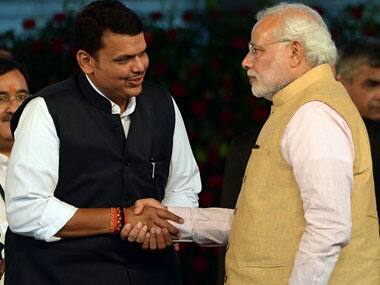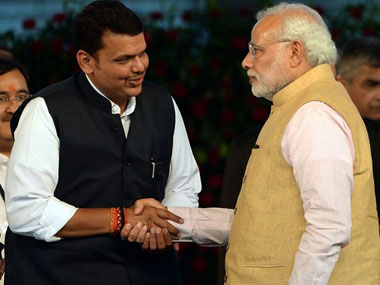The Devendra Fadnavis-led BJP government in Maharashtra may have won a trust vote by voice acclaim today (12 November) and also succeeded in installing a Speaker of its choice, but its uncertainties are only just beginning. Given the kind of party-wise seat break-up in the assembly (122 BJP plus ally, 63 Shiv Sena, Congress 42 and NCP 41, and the rest independents and smaller parties), no viable majority is possible in the 288-member assembly without at least the Sena or the NCP backing the BJP formally. The smaller parties and independents simply do take the BJP to 144 – the mid-way mark. One BJP MLA died after the election, bringing the BJP’s number down to 121 temporarily. To cobble together a viable majority, the BJP will have to manage a lot of contortions. And without a viable majority the government will not be able to pass any major laws. It will have to do murky deals to get any bill passed any time, leading to exactly the kind of deals that brought the Congress-NCP coalition into disrepute. So what are Fadnavis’ options? [caption id=“attachment_1799327” align=“alignleft” width=“380”]
 Devendra Fadnavis. AFP.[/caption] Option 1 is the best. It is for the BJP to get off its high horse and accept some of the conditions imposed by the Shiv Sena to participate in government. This could still happen if Amit Shah and Narendra Modi allow Fadnavis to work out a viable arrangement with Uddhav Thackeray, including giving his party the Deputy Chief Ministership. Option 2 is to formalise a deal with the NCP – which seems to be on the table. But the wily Sharad Pawar, even though he is known to be a more stable coalition partner, will demand a high price. Among them could be a promise not to investigate the scams of the previous government, especially those involving the NCP, and to allow NCP ministers to continue doing their skullduggery. It won’t be explicit, but this is what the bargain would be. Doing a deal with the Sena also means the same – as the Sena has been busy milking its leadership of the rich Mumbai city corporation for what it is worth. Option 3 is to get MLAs from either the NCP or the Sena to resign and contest on a BJP ticket once byelections are held. This will mean backroom deals (possibly in cash) to those willing to make a switch. This is the equivalent of BS Yeddyurappa’s Operation Lotus in Karnataka, which gave him a majority, but didn’t ultimately allow him to government. But it is possibly the choice the BJP is most likely to make if a deal with Sena is not in the works. Since no MLA wants to fight another election, there may more takers for this option in the BJP. Option 4 is to try and run a precarious minority government for as long as possible. It may not last five years, as there is no compelling reason for any of the three major parties (Congress, NCP or Sena) to allow Fadnavis to rule unhindered for that long. If Fadnavis falters on any issue, one or all of the opposition parties would gang up to bring the government down, Option 5 is a variant of 4 – a kind of Arvind Kejriwal option. It would be to run a minority government for a few months, announce some populist measures, and then dissolve the assembly to seek a full mandate. Kejriwal tried to do this in Delhi, but failed because he resigned prematurely and could not get the assembly dissolved by the Lt Governor. In Maharashtra, with the Governor having been appointed by the BJP, seeking assembly dissolution will be easier, as long as Congress, NCP and Sena don’t collectively stake a claim. Their numbers add up to a majority. Whichever way one looks at it, Maharashtra is in for interesting times. The BJP leadership will be ruing the fact that it tried to drive too hard a bargain with the Sena given the numbers it got on 19 October. The numbers were simply too unfriendly for the BJP to flex its muscles so much with the Sena. Now, it will have to figure out how to cross one hurdle after another in the weeks and months ahead. The trust vote was only the first of such hurdles.
Devendra Fadnavis. AFP.[/caption] Option 1 is the best. It is for the BJP to get off its high horse and accept some of the conditions imposed by the Shiv Sena to participate in government. This could still happen if Amit Shah and Narendra Modi allow Fadnavis to work out a viable arrangement with Uddhav Thackeray, including giving his party the Deputy Chief Ministership. Option 2 is to formalise a deal with the NCP – which seems to be on the table. But the wily Sharad Pawar, even though he is known to be a more stable coalition partner, will demand a high price. Among them could be a promise not to investigate the scams of the previous government, especially those involving the NCP, and to allow NCP ministers to continue doing their skullduggery. It won’t be explicit, but this is what the bargain would be. Doing a deal with the Sena also means the same – as the Sena has been busy milking its leadership of the rich Mumbai city corporation for what it is worth. Option 3 is to get MLAs from either the NCP or the Sena to resign and contest on a BJP ticket once byelections are held. This will mean backroom deals (possibly in cash) to those willing to make a switch. This is the equivalent of BS Yeddyurappa’s Operation Lotus in Karnataka, which gave him a majority, but didn’t ultimately allow him to government. But it is possibly the choice the BJP is most likely to make if a deal with Sena is not in the works. Since no MLA wants to fight another election, there may more takers for this option in the BJP. Option 4 is to try and run a precarious minority government for as long as possible. It may not last five years, as there is no compelling reason for any of the three major parties (Congress, NCP or Sena) to allow Fadnavis to rule unhindered for that long. If Fadnavis falters on any issue, one or all of the opposition parties would gang up to bring the government down, Option 5 is a variant of 4 – a kind of Arvind Kejriwal option. It would be to run a minority government for a few months, announce some populist measures, and then dissolve the assembly to seek a full mandate. Kejriwal tried to do this in Delhi, but failed because he resigned prematurely and could not get the assembly dissolved by the Lt Governor. In Maharashtra, with the Governor having been appointed by the BJP, seeking assembly dissolution will be easier, as long as Congress, NCP and Sena don’t collectively stake a claim. Their numbers add up to a majority. Whichever way one looks at it, Maharashtra is in for interesting times. The BJP leadership will be ruing the fact that it tried to drive too hard a bargain with the Sena given the numbers it got on 19 October. The numbers were simply too unfriendly for the BJP to flex its muscles so much with the Sena. Now, it will have to figure out how to cross one hurdle after another in the weeks and months ahead. The trust vote was only the first of such hurdles.
Trust vote is only the first of BJP's hurdles: Fadnavis is in for more uncertainties
R Jagannathan
• November 12, 2014, 16:54:40 IST
The BJP minority government in Maharashtra may have won the trust vote, but its trials are just beginning. For a viable majority, it has no option but to go back to the Sena. The alternative is to do murky deals with MLAs and spoil its image
Advertisement
)